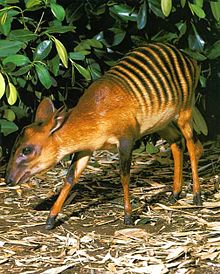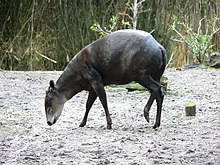Z is for Zebra Duiker
Zebra duiker
| Zebra duiker | |
|---|---|
 | |
| Scientific classification | |
| Kingdom: | Animalia |
| Phylum: | Chordata |
| Class: | Mammalia |
| Order: | Artiodactyla |
| Family: | Bovidae |
| Genus: | Cephalophus |
| Species: | C. zebra |
| Binomial name | |
| Cephalophus zebra Gray, 1838 | |
The zebra duiker (Cephalophus zebra) is a small antelope found primarily in Liberia, as well as the Ivory Coast, Sierra Leone, and occasionally Guinea.[1] They are sometimes referred to as the banded duiker or striped-back duiker. It is believed to be one of the earliest duiker species to have evolved.[2]
Taxonomy and etymology[edit]
| ||||||||||||||||||||||||||||||||||||
| Phylogenetic relationships of the bay duiker (Johnston et.al. 2012) |
The scientific name of the zebra duiker is Cephalophus zebra. The bay duiker is classified under the genus Cephalophus and the family Bovidae. It was first described by British zoologist John Edward Gray in 1838 in Annals of Natural History.[3] No subspecies are identified.[4] The generic name probably comes from the combination of the New Latin word cephal, meaning head, and the Greek word lophos, meaning crest.[5] The specific name zebra pertains to the striking resemblance this duiker bears to the zebra due to the presence of dorsal stripes.[6] The word "duiker" comes from the Afrikaans word duik, or Dutch duiker - both mean "diver".[7] The zebra duiker is locally known as the marking deer in Liberia.[8]
A 2001 phylogenetic study divided Cephalophus into three distinct lineages: the giant duikers, east African red duikers and west African red duikers. However, the status of two species, the zebra duiker and the Aders' duiker, remained dubious.[9] In 2012, Anne R. Johnston (of the University of Orleans) and colleagues constructed a cladogram of the subfamily Cephalophinae (duiker) based on mitochondrial analysis. They showed that within the "giant duiker" group, the bay duiker formed a clade with Jentink's duiker, and the zebra duiker is sister to this clade. Similarly, Abbott's duiker and yellow-backed duiker form a clade sister to Sylvicapra. The bay duiker and Jentink's duiker probably evolved during the Pleistocene, less than 2.5 million years ago.[10]
Description[edit]
Zebra duikers have gold or red-brown coats with 12-16 distinctive zebra-like stripes, dark markings on their upper legs, and russet faces. Newborns appear darker because they are born with their stripes closer together. An adult can grow to 90 cm (35 in) in length, 45 cm in height, and 20 kg (44 lb) in weight. Their horns are short and round with sharp pointed tips. They are about 4.5 - 5.0 cm long in males, and half that in females. Female body size is larger than males, possibly due to long gestation periods.
Dental Formula:
0/3 I, 0/1 C, 3/2-3 P 3/3 M = 30-32 total[11]
Habitat[edit]
Zebra duikers live in lowland primary rainforests, particularly by clearings and along forest margins. They are most commonly found in forested areas of the midwestern parts of Africa.[12] They can less commonly be found in hill and low-mountain forests.
Diet[edit]
They are ruminants which feed primarily on fruit, foliage, and seeds. Though rare, there is evidence that they may eat rodents on occasion. Their reinforced nasal bones enable them crack open the hard exterior of certain fruits.[13]
Reproduction[edit]
The gestation period is anywhere from 221 to 229 days and the female is receptive to mating about 10 days after parturition.[14] The mother will only birth one calf at a time. A newborn can weigh from 1270 to 1550 g at birth. During the first ten days after birth, referred to as the lactation period, a newborn grows at a rate of about 94 g/day.[15] After that, the growth rate decreases considerably. Females reach sexual maturity at 9–12 months of age and males reach sexual maturity at 12–18 months. Cephalophus zebra is the only duiker species with the diploid number 2n=58.
Social behavior[edit]
Zebra duikers have displayed diurnal activity when living in captive situations, but mostly nocturnal in the wild. They are solitary animals that form pair bonds for breeding purposes. Both the male and female participate in the defense of young and home range. Adaptations include stripes and thickened nasal/frontal bones. The stripes may reduce injury to the more vulnerable abdominal area. The stripes may also make it more difficult for some predators to identify by breaking up the outline of their forms. The nasal bones allow for protection against blunt force during altercations.
Economic importance[edit]
They are hunted for bush meat. Their hides and other inedible parts can also be utilized by humans.[16]
Conservation[edit]
They are considered Vulnerable by the IUCN due to deforestation, loss of habitat, and overhunting within its range. Zebra duikers are common prey to Leopards, African Gold Cats, African Rock Pythons, and the Crowned Eagle. The zebra duiker has been described as the species least capable of adapting of all West African Duiker species and most likely to become extinct. The wild population is estimated at 28,000 individuals. This estimation is believed to be high and continues to decline. Having once been more widespread, it is now more common in protected areas, in particular the Gola National Park in Sierra Leone, Sapo National Park in Liberia, and Taï National Park in Ivory Coast.[17] In a study conducted to identify areas of greatest conservation need, one zebra duiker was identified in an unprotected area of the Ziama Classified Forest of Guinea. This area is under consideration for classification as a national park and currently serves as a home to many species categorized as rare and threatened.[18]
References[edit]
- ^ a b IUCN SSC Antelope Specialist Group (2008). "Cephalophus zebra". IUCN Red List of Threatened Species. 2008. Retrieved 16 January 2009.
- ^ Stuart, Chris & Tilde. (2006) Field Guided to the Larger Mammals of Africa, 3rd Edition. Struik Publishers, Cape Town.
- ^ Wilson, D.E.; Reeder, D.M., eds. (2005). Mammal Species of the World: A Taxonomic and Geographic Reference (3rd ed.). Johns Hopkins University Press. p. 713. ISBN 978-0-8018-8221-0. OCLC 62265494.
- ^ "Cephalophus zebra". Integrated Taxonomic Information System. Retrieved 21 March 2016.
- ^ "Cephalophus". Merriam-Webster Dictionary. Retrieved 11 February 2016.
- ^ Prothero, D. R.; Schoch, R. M. (2002). Horns, Tusks, and Flippers : The Evolution of Hoofed Mammals. Baltimore, Maryland (USA): Johns Hopkins University Press. p. 99. ISBN 9780801871351.
- ^ "Duiker". Merriam-Webster Dictionary. Retrieved 17 February2016.
- ^ Robinson, P.T. (2013). Dop, H. (ed.). Travel Sketches from Liberia : Johann Buttikofer's 19th Century Rainforest Explorations in West Africa (Annotated English ed.). Leiden: Brill. p. 733. ISBN 9789004233478.
- ^ van Vuuren, B.J.; Robinson, T.J. (2001). "Retrieval of four adaptive lineages in duiker antelope: evidence from mitochondrial DNA sequences and fluorescence in situ hybridization". Molecular Phylogenetics and Evolution. 20 (3): 409–25. doi:10.1006/mpev.2001.0962. PMID 11527467.
- ^ Johnston, A.R; Anthony, N.M (2012). "A multi-locus species phylogeny of African forest duikers in the subfamily Cephalophinae: evidence for a recent radiation in the Pleistocene". BMC Evolutionary Biology. 12 (120): x–x. doi:10.1186/1471-2148-12-120. PMC 3523051. PMID 22823504.
- ^ http://reocities.com/rainforest/3881/stripedduiker.htm
- ^ Hoag, Hannah. "Bovids V: Duikers (Cephalophinae)." Grzimek's Animal Life Encyclopedia. Ed. Michael Hutchins, et al. 2nd ed. Vol. 16: Mammals V. Detroit: Gale, 2004. 73-85. Gale Virtual Reference Library. Web. 26 Mar. 2015.
- ^ Kingdon, Jonathan & Hoffmann, Michael eds. (2013) Mammals of Africa, Volume VI, Pigs Hippopotamuses, Chevrotain, Giraffes, Deer and Bovids. Bloomsbury Publishing, London.
- ^ Mijal, M. "Cephalophus zebra, Zebra duiker". Animal Diversity Web. University of Michigan Museum of Zoology. Retrieved 3 March 2016.
- ^ Pontier, D., et al., Postnatal growth rate and adult body weight in mammals: a new approach. (1989) Vol. 80:390-394. Springer-Verlag
- ^ The Kingdon Field Guide to African Mammals; Jonathan Kingdon; Academic Press; San Diego, California; 1997
- ^ Wilson, D.E. & Mittermeier R. A. eds. (2011) Handbook of the Mammals of the World. Vol. 2. Hoofed Mammals. Lynx Edicions, Barcelona.
- ^ David Brugiere, Identifying Priority Areas for the conservation of antelopes in the Republic of Guinea, West Africa, using the complementary approach. Fauna and Flora International, Oryx, 46(2), 253-259; 2012








